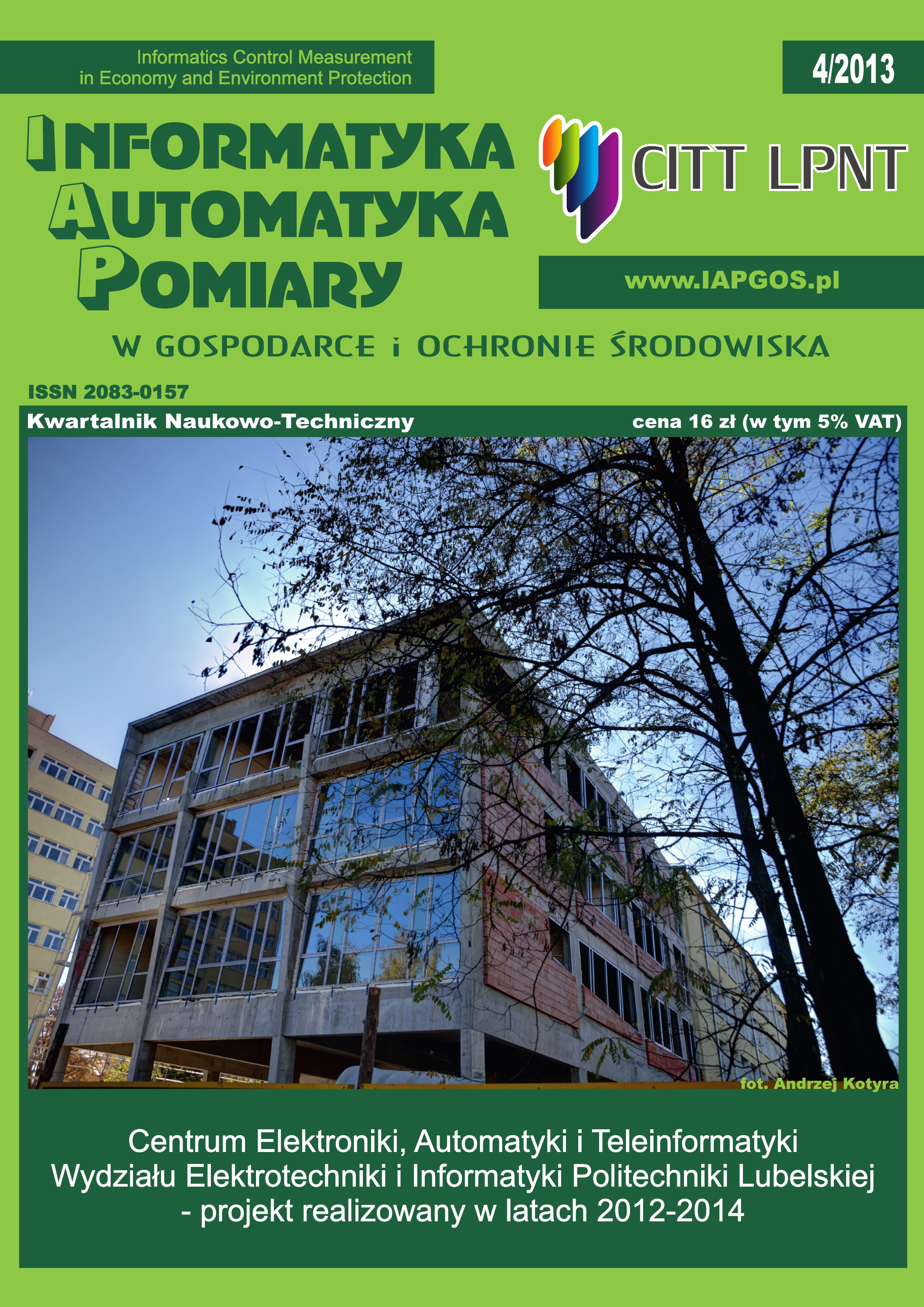HYBRID FINITE ELEMENT METHOD IN MODELING OF MACHINE TOOLS KCI 210/280 NM
Article Sidebar
Open full text
Issue Vol. 3 No. 4 (2013)
-
HYBRID FINITE ELEMENT METHOD IN MODELING OF MACHINE TOOLS KCI 210/280 NM
Janusz Grzywocz3-6
-
ENHANCEMENT OF LOW-DOSE CT SCANS
Tomasz Węgliński, Anna Fabijańska7-9
-
IMAGE ANALYSIS METHODS – ANALYSIS OF MAMMOGRAPHIC IMAGE BASED ON TEXTURAL FEATURES
Jagoda Lazarek10-13
-
COMPARISION OF SELECTED FLAME AREA DETECTION METHODS IN VISION DIAGNOSTIC SYSTEM
Daniel Sawicki, Andrzej Kotyra14-17
-
THE DESIGN OF READOUT FRONT-END ELECTRONICS FOR TIME AND ENERGY MEASUREMENTS FOR SEMICONDUCTOR STRIP DETECTORS
Rafał Kłeczek18-21
-
THE ELECTRICAL CHARACTERISTICS OF A CATENARY SYSTEM IN ELECTRIC RAIL VEHICLES, THE CALCULATION OF TRACTION LOAD AND SHORT – CIRCUIT CURRENTS
Włodzimierz Kruczek22-25
-
DEVELOPMENT OF A SCENARIO-BASED PROJECT MANAGEMENT SYSTEM CONSTRUCTION IN ENTERPRISES WITH THE FUNCTIONAL ORGANIZATIONAL STRUCTURE
Olexandr Koval, Valeriy Kuzminykh, Maxim Voronko, Dmitriy Khaustov26-30
-
ESTIMATION OF THE SHAPE OF THE HYSTERESIS LOOP IN THE DEFORMATION OF CURRENT AND VOLTAGE OF THE TRANSFORMER
Wiesław Brociek, Robert Wilanowicz31-34
-
ARCHITECTURE OF A SERVER APPLICATION FOR USE IN ENVIRONMENTAL PATIENT MONITORING
Wojciech Surtel, Marcin Maciejewski, Rafał Różalski35-37
-
A MODEL OF A MOBILE ANDROID APPLICATION FOR ENVIRONMENTAL PATIENT MONITORING
Wojciech Surtel, Marcin Maciejewski, Michał Cieślar38-40
-
OPTIMIZATION OF AFFILIATION DETERMINATION OF GEOPOINTS TO LIMITED AREAS ALGORITHMS FOR THE USE OF THE OPENSTREETMAP PROJECT
Rafał Jachowicz, Dominik Sankowski41-44
-
MAGNETIC FIELD IN RECTANGULAR BUS-BARS OF FINITE LENGTH
Tomasz Szczegielniak, Zygmunt Piątek, Dariusz Kusiak45-48
-
ANALYSIS OF INSULATION TRANSFORMERS SYSTEM RISKS FROM SWITCHING OVERVOLTAGES
Piotr Pająk49-52
-
WEB APPLICATION DEVELOPMENT USING THE PEAR LIBRARY
Beata Pańczyk, Michał Duszyk53-58
-
USING OF NUMERICAL METHODS FOR CALCULATION THE EQUATION FOR CLUSTERS CONCENTRATIONS IN GASEOUS MATERIALS
Alexey Bublikov, Natalia Denisova, Tamara Segeda59-62
-
ANALYSIS OF FRACTIONAL ORDER PIλDμ POWER CONTROL OF A NUCLEAR REACTOR
Bartosz Puchalski, Kazimierz Duzinkiewicz, Tomasz Rutkowski63-68
-
COMBINED CLONAL NEGATIVE SELECTION ALGORITHM FOR DIAGNOSTICS OF COMBUSTION IN INDIVIDUAL PC BURNER
Andrzej Smolarz, Volodymyr Lytvynenko, Olga Kozhukhovskaya, Konrad Gromaszek69-73
-
DETERMINATION OF ELECTROMAGNETIC RADIATION EMITTED BY TELECOMMUNICATION EQUIPMENT OF TRANSMISSION CENTERS
Oleksandr Naumchuk74-76
-
DESIGN OF DYNAMIC STRUCTURAL MODELS OF INFORMATION MANAGEMENT SYSTEM OF MOVING OBJECTS
Maksym Korobchynskyi, Oleg Mashkov78-80
-
AUTOMATION OF THE SMART HOUSE SYSTEM-LEVEL DESIGN
Vasyl Teslyuk, Vasyl Beregovskyi, Andrii Pukach81-84
Archives
-
Vol. 7 No. 4
2017-12-21 23
-
Vol. 7 No. 3
2017-09-30 24
-
Vol. 7 No. 2
2017-06-30 27
-
Vol. 7 No. 1
2017-03-03 33
-
Vol. 6 No. 4
2016-12-22 16
-
Vol. 6 No. 3
2016-08-08 18
-
Vol. 6 No. 2
2016-05-10 16
-
Vol. 6 No. 1
2016-02-04 16
-
Vol. 5 No. 4
2015-10-28 19
-
Vol. 5 No. 3
2015-09-02 17
-
Vol. 5 No. 2
2015-06-30 15
-
Vol. 5 No. 1
2015-03-31 18
-
Vol. 4 No. 4
2014-12-09 29
-
Vol. 4 No. 3
2014-09-26 22
-
Vol. 4 No. 2
2014-06-18 21
-
Vol. 4 No. 1
2014-03-12 19
-
Vol. 3 No. 4
2013-12-27 20
-
Vol. 3 No. 3
2013-07-24 13
-
Vol. 3 No. 2
2013-05-16 9
-
Vol. 3 No. 1
2013-02-14 11
Main Article Content
DOI
Authors
Abstract
This article presents use of hybrid finite element method in modeling of machine tool KCI 210/280 NM. In view of innovative use in modeling engineering hybrid finite element method (HFEM) in article presents way of modeling and next chosen variants treatment of group machine tool as rigid or flexible. Also presents impact of elastic-damper elements on the obtained results. In research perform conducted static stiffness along the x and y - axis machine tool. In conclusion the obtained results were compared hybrid (HFEM) and classical finite element method (FEM) for the experimental research.
Keywords:
References
Grzywocz J.: Analiza wpływu uproszczeń modelu geometrycznego obrabiarki KCI 210/280 NM na wyniki uzyskane metodą elementów skończonych. Prace Naukowe Katedry Budowy Maszyn, nr 2/2011, poz. 11.
Kono D., Lorentzer T., Weikert, S, Wegener K.: Comparison of rigid body mechanics and finite element method for machine tool evaluation.
Kaźmierczak M.: Praca doktorska: Metodyka badań sztywności statycznej obrabiarek ciężkich w warunkach przemysłowych. Gliwice 2005.
Kruszewski J., Sawiak S., Wittbrodt E.: Wspomaganie komputerowe CAD/CAM. Metoda sztywnych elementów skończonych w dynamice konstrukcji. WNT, Warszawa, 1999.
Łaczek S.: Modelowanie i analiza konstrukcji w systemie MES - ANSYS v.11. PK, Kraków 2011.
Mattern S., Blankerhorn G., Schweizerhof K.: Comparison of building collapse simulation results from finite element and rigid body models, 2006. DOI: https://doi.org/10.1007/978-1-4020-5981-0_23
www.ansys.com.
Article Details
Abstract views: 216
License

This work is licensed under a Creative Commons Attribution-ShareAlike 4.0 International License.






